 For some time now, I’ve been trying to make progress in ascertaining the previous ownership of both the manuscripts and the cartonnage (from mummies and other sources) that ended up in the Green Collection. This post will focus on the mummy masks. For the record, there are several mummy masks that have been associated with the Green Collection over the years. Most famously, there was the mask that was dismantled by Scott Carroll and a group of students at Baylor University in January of 2012, which was documented in a video on Youtube.
For some time now, I’ve been trying to make progress in ascertaining the previous ownership of both the manuscripts and the cartonnage (from mummies and other sources) that ended up in the Green Collection. This post will focus on the mummy masks. For the record, there are several mummy masks that have been associated with the Green Collection over the years. Most famously, there was the mask that was dismantled by Scott Carroll and a group of students at Baylor University in January of 2012, which was documented in a video on Youtube.
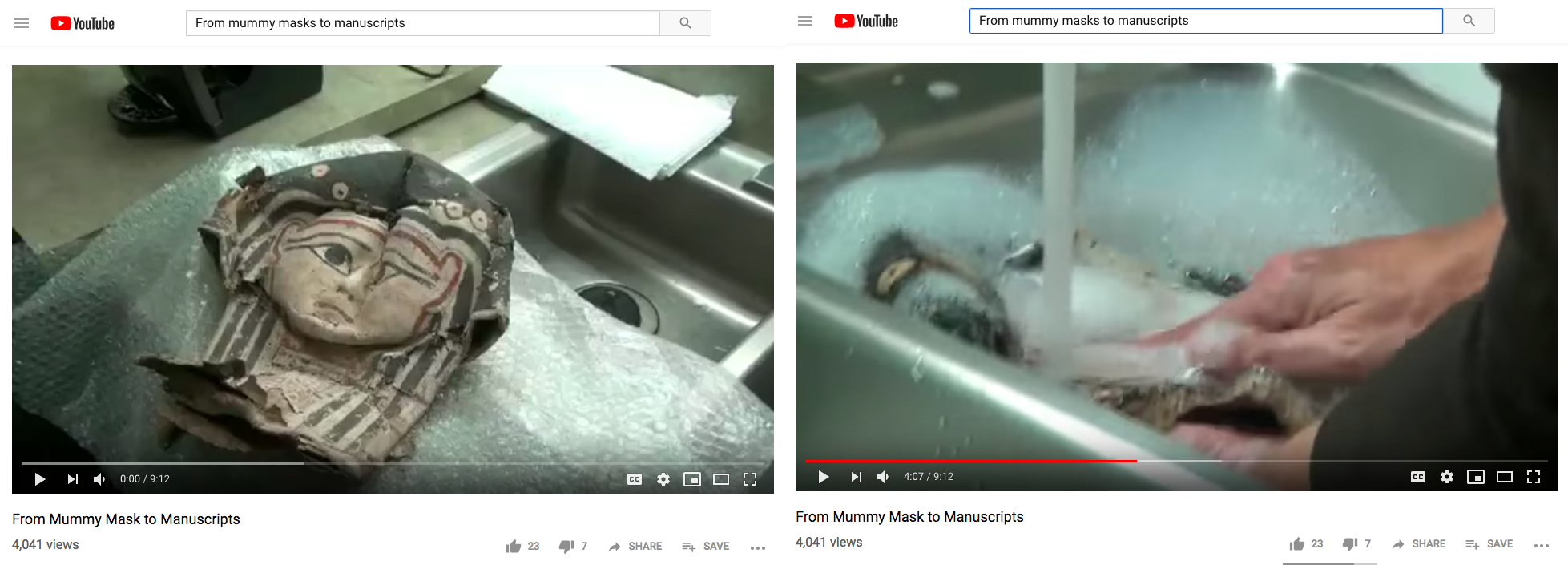
There are also various pieces that went on display in the travelling “Passages” exhibitions, such as the pair below, which were included in a video associated with the iteration of “Passages” on display in Springfield, Missouri in 2014:
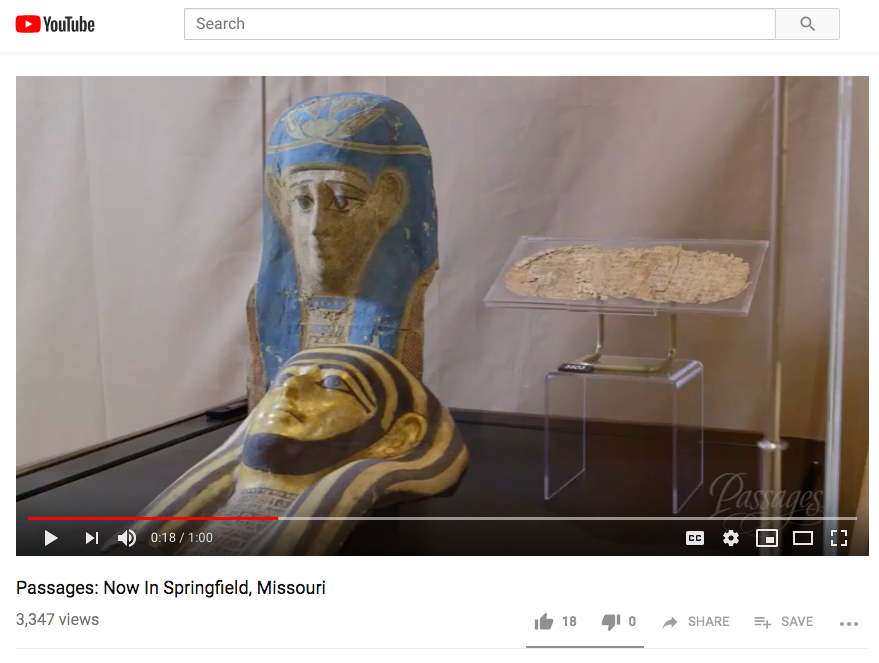
Still another mask has appeared in publications associated with the “Passages” exhibition, such as this item from Scott Carroll, Passages: 400th Anniversary of the King James Bible (Oklahoma City: Passages, 2012):

The same mask has featured in Scott Carroll’s public presentations:

It appears to be this mask that was dismantled at some point (again at Baylor University) as recorded in a series of slides in a 2016 lecture by Scott Carroll:

Finally, there was a mask that was said to have been dismantled by Jerry Pattengale during the LOGOS seminar in the summer of 2013 at Oxford. I have been unable to find photos of the mask itself, but there is a video overview of that seminar with a clip of Pattengale sitting at a table with what appears to be drying papyrus fragments. Pattengale presented a better image of the event in the Colorado Springs “Passages” Speaker Series (thanks to David Bradnick for the screen shot):
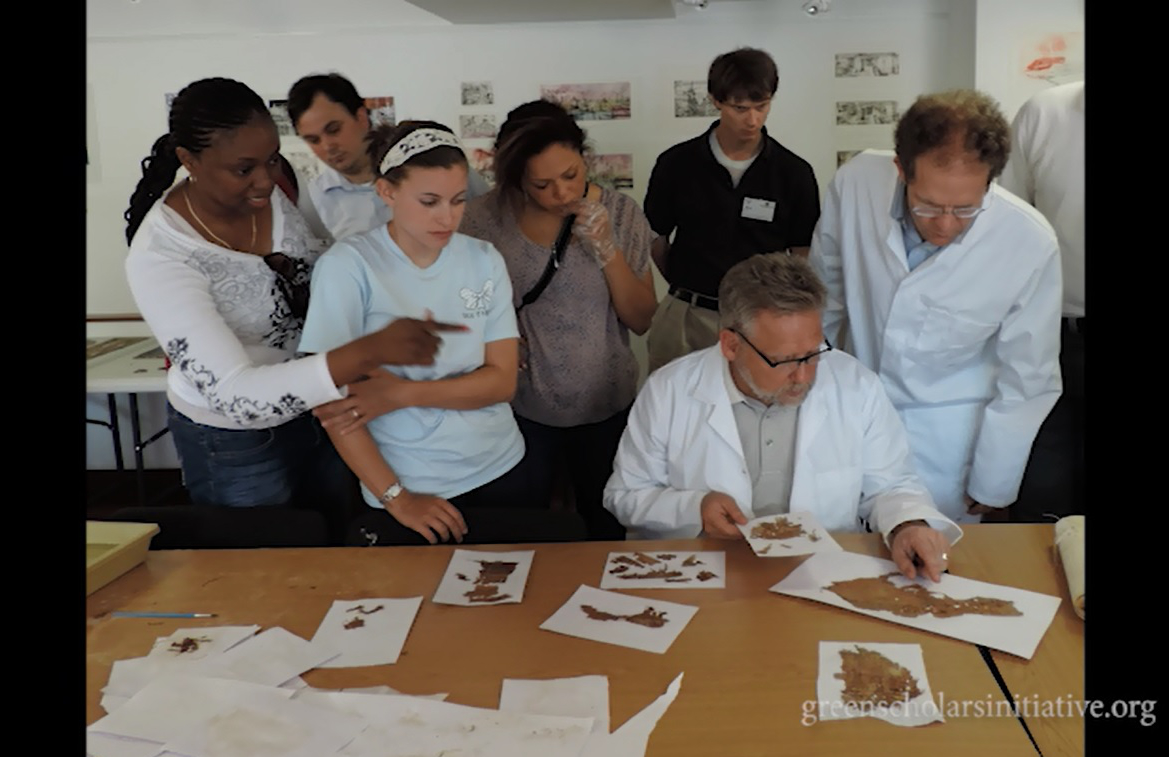
There is also a description of the 2013 event by one of the students involved:
“I experienced the thrill of discovery and exploration as we worked with a mummy mask, dipping it in a series of chemical baths, each carefully mixed at precisely the right temperature, in hopes of finding within the layers of papyri some fragments with text on them. . .We not only watched this delicate procedure, but we were also part of the process. I prepared sheets of art paper for Dr. Pattengale as he gently peeled large papyrus fragments off the mask made of cartonnage, an ancient paper-maché-like material that is a major source for biblical fragments.”
[Update 30 January 2019: Thanks to David Bradnick for pointing out this gilded mask that was displayed during the first Verbum Domini exhibit in 2012]:
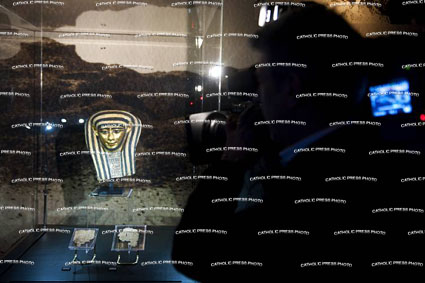
If anyone knows of additional images of different masks in the Green Collection, I would be grateful for images and links, which I will add to this page to keep a running record.
Brice Jones and Roberta Mazza first drew attention to the Green Collection’s masks several years ago, and one of the main questions they asked remains unanswered: Where did these mummy masks come from?
My working assumption had been that at least some of the mummy masks might be acquired from the various lots that show up in the major auction houses from time to time. Another less happy possibility is that these masks might be the result of looting in Egypt in recent years. But in the course of reviewing yet another video of Scott Carroll uploaded in 2015 (described in more detail here), I noticed a couple offhand remarks that were potentially illuminating in regard to the question of at least one of the sources of the Green Collection’s mummy masks. While describing how he goes about evaluating the papyrus cartonnage from mummy masks that he purchases, at about the 23:25 mark in this video, Scott Carroll says the following:
“Even my wife has been with me in these crypts. You know, underneath Oxford University, looking, you know,. . . and you’re looking at these mummy masks. . .“
And at the 18:10 mark in this video, while again discussing the source of his materials:
“. . .The papyri, the cartonnage, mummy coverings and things–those things were collected, uh, in the 1920s, the 1930s; and they’re in boxes underneath universities and in private holdings in different places. . .”
The connection with Oxford University raises flags. I was aware that the Green Collection has purchased from organizations affiliated with Cambridge University before (the Codex Climaci Rescriptus, bought by the Green Collection in 2010 from Westminster College, Cambridge), but I’m not aware of purchases from Oxford. What location in Oxford might Carroll be describing? Oxford no doubt has numerous buildings housing ancient Egyptian remains (the Ashmolean Museum of course comes to mind). But there is also some online documentation, in the form of a series of alamy stock photos taken in 2005, of another room at Oxford containing numerous Egyptian mummy masks in boxes:

If the caption in this photo is correct, this mask is at Christ Church, Oxford. The masks depicted in this series resemble some of those excavated by the Graeco-Roman Branch of the Egypt Exploration Society:

Mummy cartonnage from the flickr stream of the Egypt Exploration Society (GR.NEG.056); image source: The Egypt Exploration Society
And the storage methods also resemble the some of the techniques used by Grenfell and Hunt for storing papyri, such as the metal boxes in the background of the two photos below:

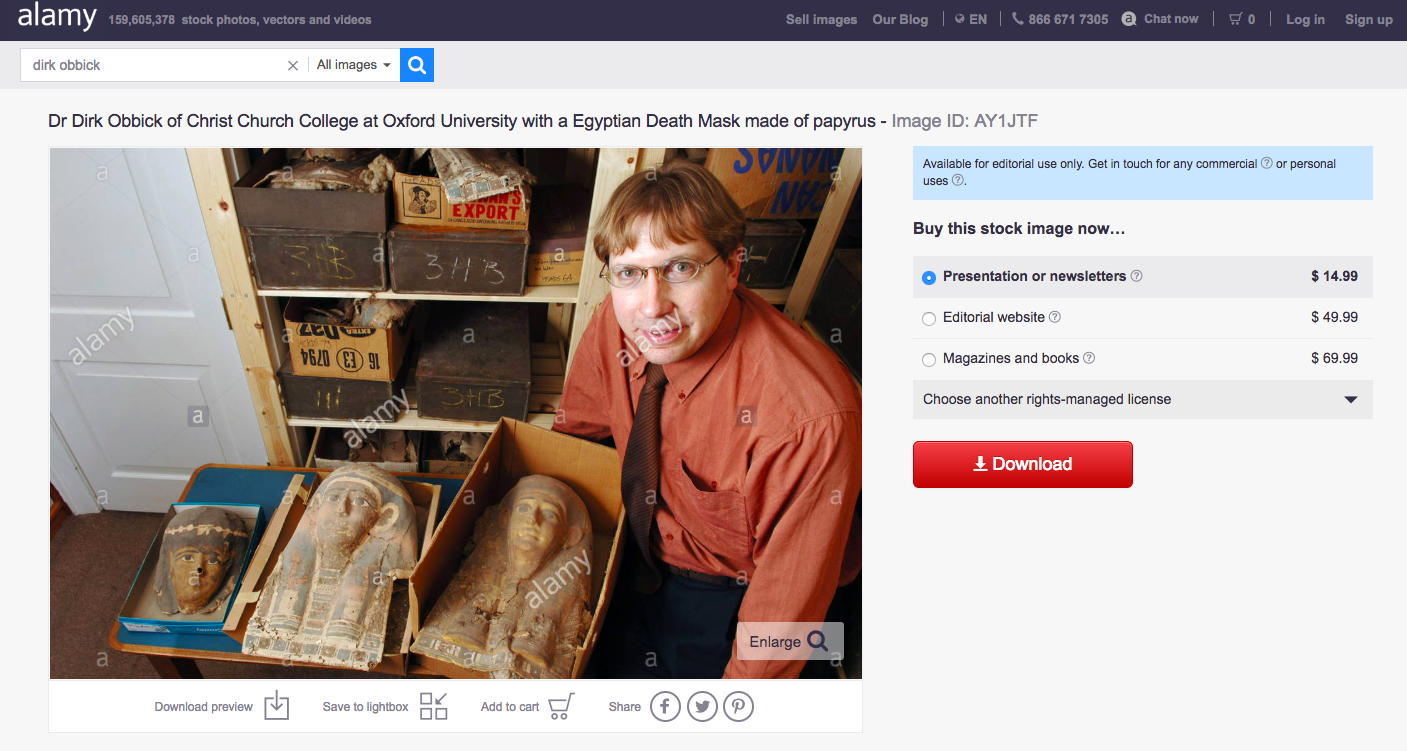
The gentleman in the photos is Professor Dirk Obbink of Christ Church, Oxford, who has at times over the years been associated with the Green Collection in different capacities. (It would be interesting to learn whether the masks in these images are the personal property of Professor Obbink or the results of EES excavations.) In the early days of the “Passages” exhibitions, Professor Obbink was featured quite prominently in the promotion of the Green Collection and what was then known as the Green Scholars Initiative.
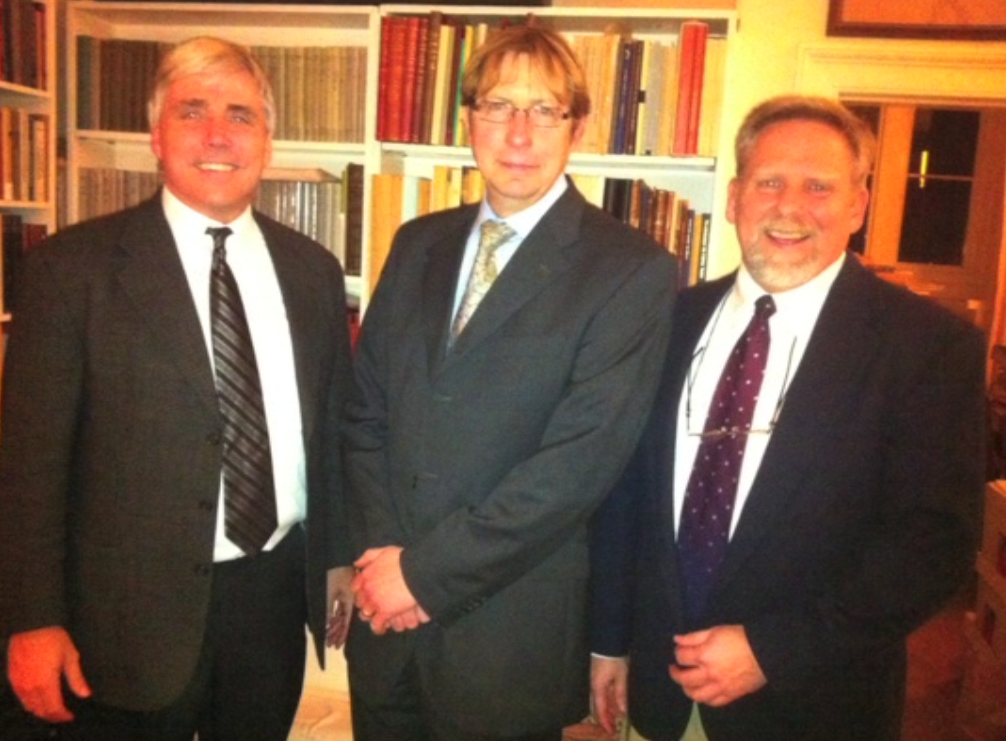
Scott Carroll, Dirk Obbink, and Jerry Pattengale, circa 2011; image source: Jerry Pattengale’s introduction for Dirk Obbink in Vol. 1 of the Passages Speaker Series.
Professor Obbink appears twice in the listings of “Passages” Speakers Series lectures, once with a talk on “Papyri Discoveries and Bible Translation” (September 2011) and once for a joint presentation with Jerry Pattengale entitled “Unveiling Cartonnage: The Practice and Value of Dissolving Reused Papyri Manuscripts for Biblical Studies” (December 2014). At roughly the same time, Professor Obbink was also editing papyrus fragments of Sappho, some of which had been acquired by Scott Carroll and were at one time said to have come from mummy cartonnage. A Tweet of 30 May 2013 from the @PassagesExhibit account suggests that Professor Obbink was actively dismantling mummy cartonnage in those days:
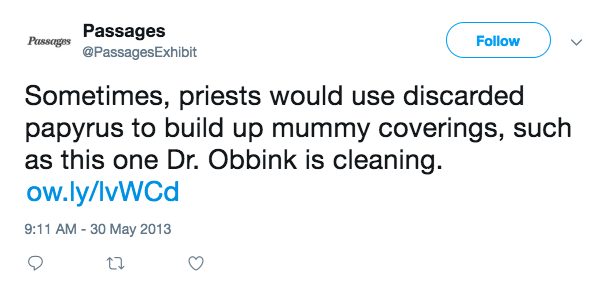
The link in the Tweet eventually leads to this image:
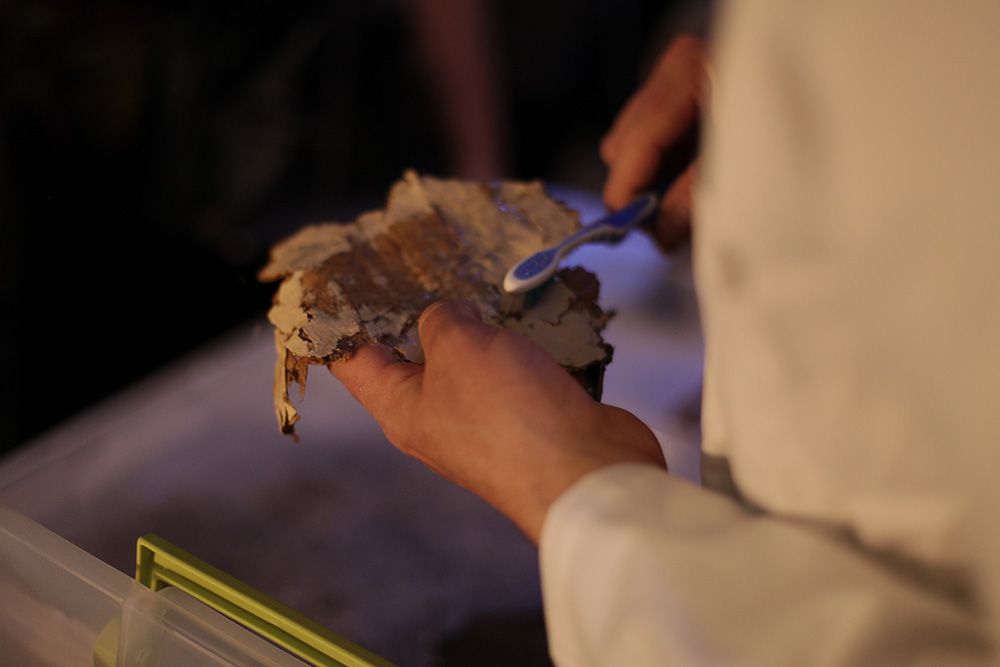
The image seems to be part of a VIP event held in association with the “Passages” exhibit in Colorado Springs in 2013, in which Jerry Pattengale and Professor Obbink dismantled a mask (presumably one owned by the Green Collection) for a crowd of spectators. This was mentioned by Jerry Pattengale in the “Passages” Speaker Series videos (again, thanks to David Bradnick for screen shot):

In any event, the close association between Pattengale, Carroll, and Professor Obbink (as well as the Green Collection and Oxford) has long been known, and Professor Obbink appears to still be on the Museum of the Bible payroll. was affiliated in some respect with the Museum of the Bible through 2017 [Update: See Mike Holmes’s comment below]. What was news to me was Carroll’s suggestion that Oxford was a source of the mummy masks that he was purchasing (his usual practice in describing provenance in these more recent videos is to say the material comes from “families” looking to sell things).
Scott Carroll has also suggested that Professor Obbink offered at least one artifact from the Egypt Exploration Society’s collection for sale (the Oxyrhynchus papyrus P.Oxy 83.5345, a fragment of the Gospel According to Mark). Professor Obbink and the Egypt Exploration Society have both denied Carroll’s claims in regard to that papyrus. [[Update 9 July 2019: Mike Holmes has provided documents that suggest Professor Obbink allegedly offered at least four items in the Egypt Exploration Society’s collection for sale to Hobby Lobby. And, according to Museum of the Bible records, Professor Obbink legally sold other manuscripts to the Green family.]] Now we would seem to be in a similar situation with regard to the Green Collection mummy masks, in that all we really have connecting the Green Collection masks to Oxford is the word of Scott Carroll. And once again, it is the Green Collection and the Museum of the Bible that could shed light on these questions by offering some transparency in their acquisition records for these artifacts.
Addenda (6 February 2019): Two quick notes: I should add that in this video, Scott Carroll mentioned that “a number of mummy heads” (4:33) were also present during the alleged negotiations with Dirk Obbink for the sale of “first century Mark” (P.Oxy. 83.5345). And here is a shot of another gilded mummy mask used in a promotional video for the Museum of the Bible that was uploaded in August 2015:

[[Update 9 July 2019: David Bradnick provides an image of an additional Green Collection mask that was on display in the La Biblia exhibit in Cuba in 2014. It is GC.MMY.000154:]]
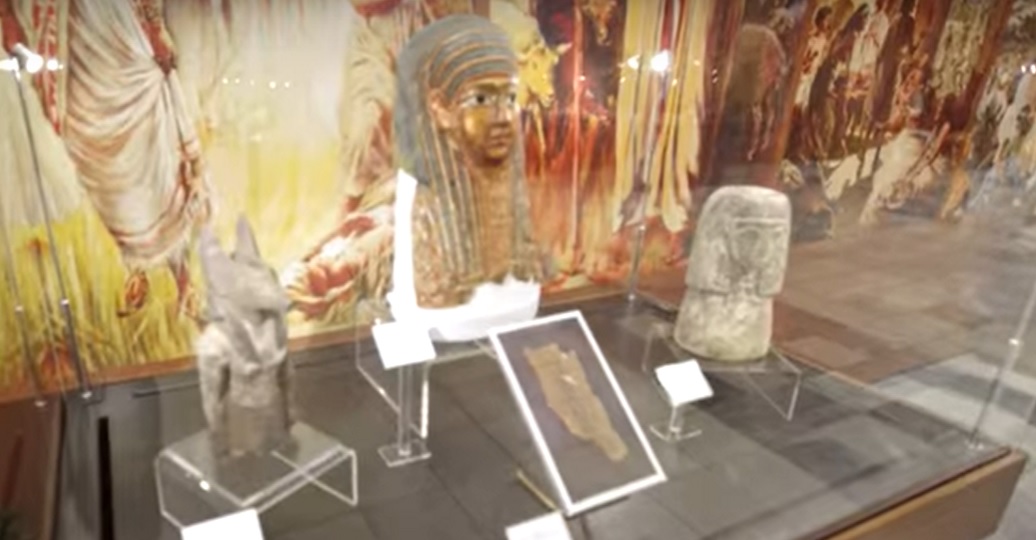


I am curious to know how Robert Draper knew where to find the Mark fragment before it was published. Daniela Colomo told him that they weren’t going to take an official position for the fragment until pressured to do so. Very strange.
I would also like to know who at the EES instructed Obbink to prepare and publish the fragment.
That’s an interesting point about Robert Draper. I hadn’t thought about the chronology of that.
In his Feb. 1, 2012 debate with Ehrman, Dan Wallace mentioned that the Mark text was dated by “a papyrologist who worked on this manuscript – a man whose reputation is unimpeachable. Many consider him to be the best papyrologist on the planet.” Also, during the 2012 Atlanta Passages Speaker Series, Carroll mentions seeing it with Obbink at Oxford (Feb. 7, 2012). Pattengale also claims to have seen it with Carroll (Feb. 14, 2012). In 2015, at the National Conference on Christian Apologetics, Carroll said that Obbink was publishing P137 and that it was in Obbink’s possession both times Carroll saw it. So Obbink’s connection to P137 was rumored for years, which likely led Draper to Oxford.
Also, notable: According to EES, “Obbink says that he did show the papyrus in his rooms (where it was temporarily for teaching purposes) to Scott Carroll, but to no-one else except some Oxford students.” So, in relation to Pattengale’s claims of seeing the text, the stories don’t quite match.
As I recall; the internet narrative of ‘First Century Mark’ in 2017, had already established Dirk Obbink’s billiard table in Christ Church as where it had been seen in 2012. If Robert Draper was nosing around Oxford (and Obbink wasn’t talking), it might not be strange that he would seek out Daniela Colomo just up the road. And then struck lucky.
Makes sense.
Makes sense
Reblogged this on Talmidimblogging.
I am not an Egyptologist; I do not know whether the following is relevant, e.g., if some cartonnage mss are later than expected. From New Haven Register, April 1, 1898, page 6.
“Perhaps the explanation of the origin of the large numbers of mummies that have latterly been offered for sale may be found in an article by Dr. [Georg] Ebers in the Allgemeine Zeiting, in which collectors are warned against the mummy masks which have latterly been freely offered to dealers. Some of these specimens, which are so skillfully got up that they might deceive the very elect, have been carefully examined, with the result that the wood has been shown to bear traces of the saw and the colors to be mixed with oil; whereas the ancient Egyptians would have used a knife and wax. More disquieting still is the statement–entirely uncorroborated, it is true–that since the British occupation the prisoners in all the khedive’s goals [sic, gaols] have been almost exclusively employed in producing sham curios. After trying their ‘prentice hands on scarbaei [last letter unclear, maybe l, sic], frontlets and bronze statuettes, the criminals are trained to turn out entire mummies, sarcophagi, and even papyri.”
At one time, the Greek Collection also possessed (maybe they still do?) the Polychrome and Gilt Cartonnage Mummy Mask (GC.MMY.000152). It was on display as part of the Passages exhibit. I believe this is the same one displayed at Verbum Domini (2012) pictured here:
http://www.catholicpressphoto.com/servizi/2012-02-29%20Verbum%20Domini/ppages/ppage5.htm
We don’t know the particulars of the Green catalog system, but if the numbering of the mummy mask collection started at .000001, then the Greens may have owned at least 152 mummy masks.
Furthermore, the Museum of the Bible was designed with a laboratory display, and Steve Green envisioned this to be a place where mummy masks could be dissolved According to Sandra Hindman’s article, “Visitors will be able to participate in the actual procedure, and others can watch from outside the glass box in the museum” (Hindman, p. 36, 2013). This suggests that the Greens had amassed a substantial collection or that they were optimistic about their ability to obtain a significant number of masks.
We should also remember that Carroll continued to peddle the mummy mask narrative in late 2013, after he left the Green Collection. In Dec.5-6, 2013 he was featured at Josh McDowell’s, “Discover the Evidence” Conference. Here Carroll displayed at least two mummy masks that were in his possession.
https://www.josh.org/resources/apologetics/discover-the-evidence/
Thanks, David. This is good to know. And wow–the idea that they could have had over 150 masks (already by 2012)! Stunning. It’s also interesting about the plan to have live mask dismantling be a part of the Museum. Something sort of like that was said to have been a part of the “Passages” exhibition: “An archaeological tent site revealing how biblical texts are recovered from ancient Egyptian mummy masks” (https://web.archive.org/web/20150801030852/https://www.museumofthebible.org/news/passages).
I saw the Passages exhibition at one point, and I remember there was at least one mummy mask on display, but nothing ”practical” related to dismantling.
Sorry I’m just catching this post and these comments now. David and Brent: The numbering system for items usually started at GC.XXX.000105. All other things equal, they would then ascend in chronological order by accession date.
— Sometimes numbers would be skipped, due to a minor glitch in the early electronic database system used (augmented by human error).
— I assigned the number PAP.000105 to the GC’s portion of “New Sappho” in early July 2013, when I did not adequately understand accession processes. (There were at that time no papyri in the database with numbers below 116.) That material had been discovered in December 2011/January 2012, but cataloguing procedures were irregular, so it had not yet been catalogued in the database.
Brent, this is fine investigative work. Well done. One bit I can add is that I am pretty sure the photo from the 2013 LOGOS event is taken in Obbink’s office at Christ Church.
No, it is not – unlike possibly the Alamy photos. But it may be from elsewhere in College (though I don’t know where) or in the city / university.
Having studied at the University of Cambridge I was surprised to hear about Westminster College, since I’d never seen it in any of the lists of the constituent colleges of the University. So I looked it up and I feel obligated to point out that – though it is based in Cambridge – it is not, in fact, affiliated with the University of Cambridge. Rather, it is an independent theological institution connected to the United Reformed Church. (Cf. their wikipedia page: https://en.wikipedia.org/wiki/Westminster_College%2C_Cambridge#Today)
(That said, I’m still a little confused how they’ve managed to get a .cam.ac.uk web address. That’s very, very misleading.)
Thank you for that clarification (I’m not entirely familiar with the College system at U.K. institutions; I’ve tried to adjust the wording of the post to be more accurate). From the website of the college: “We are both a theological institution and a College affiliated to the main University of Cambridge” (https://www.westminster.cam.ac.uk/commercial/about).
No worries, the college system is a little bit complicated to explain. Students and staff belong to colleges which have a certain amount of institutional autonomy, but all the various departments and faculties like the faculty of Classics, faculty of Medieval and Modern Languages, etc. are part of the wider university. And only the university itself issues degrees. There are a few independent theological colleges and charities that have some connections that have connections with the university that have been formalised to a greater or lesser degree, but they are not fully recognised as part of the main 31 constituent colleges. (i.e. https://map.cam.ac.uk/colleges)
I only wanted to point this out to say it is a little bit misleading to imply that Cambridge University itself has been dealing directly with the Green Collection, when it is only one of these marginally affiliated theological institutions over whose activities the corporate body of the university does not have any real oversight as far as I am aware.
If it were, alternatively, the central university library selling off collections, then that would definitely be the university.
Re the current relationship between MOTB and Prof. Obbink: In November 2017, the Museum took steps to bring its relationship with Prof. Obbink to a close. The Museum and the professor have gone their separate ways since very early in 2018.
Thanks, Mike. I’ve updated the post to reflect this information.
I have to wonder why MOTB took steps to end their relationship with Obbink. With all the hooplah surrounding FCM, Sappho, and the like, I would have thought it would have been Obbink to end the relationship rather than the other way around.
Im wondering about this point Mazza made in relation to the provenance of the Mark fragments,
1) There is not a single New Testament or early Christian papyrus published so far coming from mummy cartonnage. Correct me if I am wrong, please. Mummy cartonnage = a sort of papier-mâché constituted by various materials sometimes including recycled papyri and used for fabricating masks and other covering panels for mummies.
2) According to current scholarship and archaeological finding, the use of recycling papyri for making mummy masks and panels ended in the early Augustan period, i.e. when Jesus was not even born or just a child. So what reported under point 1) is unsurprising. We have hundreds Ptolemaic papyri coming from mummy cartonnage, very few from the Roman period, and at the moment all dated inside this span of time.
Yes, the consensus among scholars is that the practice of using inscribed waste papyri for mummy coverings seems to have died out in the Augustan period. The standard references for this point are:
The standard references for the point are:
Eric Turner, Greek Papyri: An Introduction (2nd ed., 1980), page 31:
“In 1898/9 and 1900 Grenfell and Hunt went back to the villages on the west side of the Fayyum, where the ancient sites were in immediate peril. In these villages their success was only moderate compared with the finds from Oxyrhynchus. But they had already learned that on town sites texts of the Ptolemaic period were usually so deeply buried by the later occupation levels that normally they were ruined by damp. Flinders Petrie’s texts from Gurob pointed a way to the discovery of earlier papyri: as already indicated, they were waste-paper made into cartonnage for mummy wrappings (a method commonly used in the third century before Christ, and one which lasted in some communities down to the time of Augustus, but rarely thereafter.”
and
Roger Bagnall, Reading Papyri, Writing Ancient History (1995), pages 21-22:
[After a discussion of cartonnage and non-cartonnage sources for Ptolemaic papyri, Bagnall concludes] “With the Roman period things change dramatically. After the Augustan period cartonnage plays virtually no role, and finds from habitation sites grow enormously.”
Very speculatively, while awaiting word from those with first-hand knowledge: though there was talk or rumor of a recent sale of the Mark papyrus, there evidently was no sale. The putative mummy mask sale from the same source may also be a chimera, hinted at for whatever purpose (provenance story? prestige?).
Another source has been vaguely suggested, with what credibility, I do not know: “Dr. Scott Carroll, PhD, will [on March 2, 2014 in Ventura, CA] speak on the amazing rediscovery and acquisition of early Christian era Egyptian mummies encased in ancient Scripture text. According to Dr. Marshall Foster, Christian historian, this private collection has spent decades in a railroad boxcar….”
[It may be worth noting that Mark Twain, in his Innocents Abroad (1869 Hartford ed. p. 632), says that Egyptian rail locomotives were fueled by mummies, but he was joking.]
To repeat a comment above, in 1898, several newspapers (in Munich, London, NY, etc.) reported that Georg Ebers warned collectors of mummy masks that many were then being faked with great skill.
So, for conversation’s sake, could it be possible that the circa 1898 fakers used then-available and maybe-then-little-valued scrap papyrus and that some of their work is now in the US?
Pingback: The “First Century” Mark Purchase Agreement: Some Initial Questions | Variant Readings
Pingback: El escándalo del “Evangelio de Marcos del primer siglo” | Razón y política pública
Pingback: Public-Facing Papyrology: from the News to the Classroom – Everyday Orientalism
Pingback: Dirk Obbink, Scott Carroll, and Sappho | Variant Readings
Pingback: How Many Oxyrhynchus Papyri Have Been Sold? | Variant Readings
Pingback: More Mummy and Cartonnage Material in the Green Collection | Variant Readings
Pingback: The Atlantic Article and Green Collection Cartonnage | Variant Readings